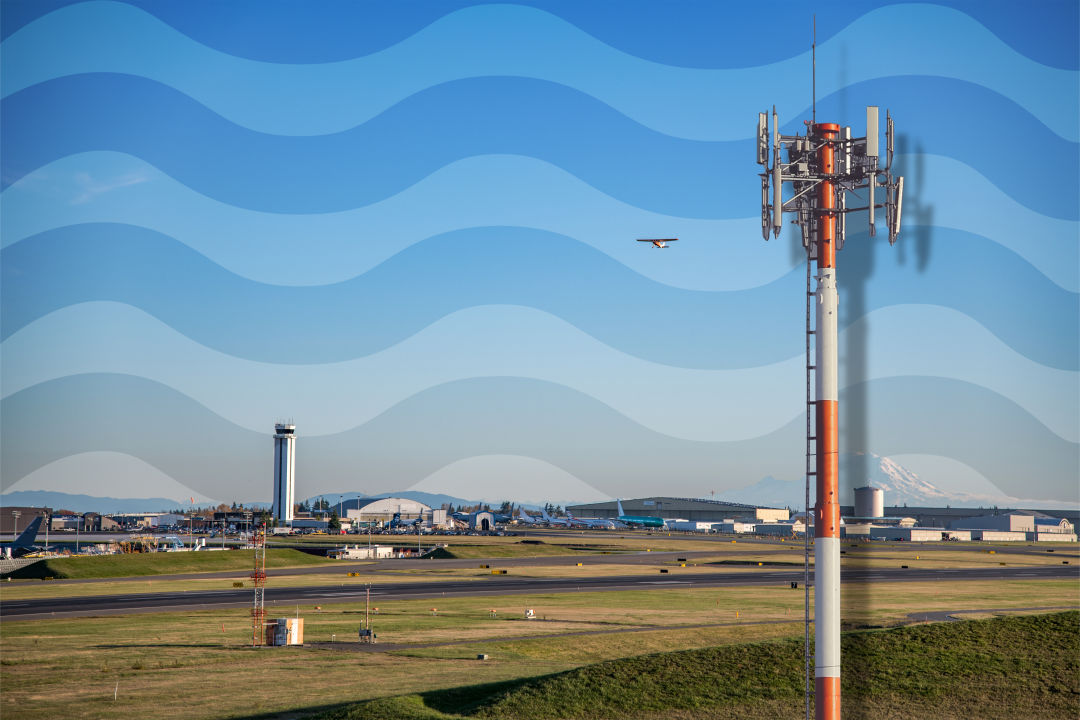What Was Up with 5G and All Those Flight Cancellations?

Paine Field was the local airport drawing headlines last month.
Image: Gage Murrey and Michael Gordon / shutterstock.com
Travel has been in flux for obvious reasons, but last month brought a new barrier to aerial escapes: 5G. When a new version of the wireless service went up in mid-January, many flights at Paine Field and other airports couldn't get off the ground. In the aftermath of these cancellations, fliers are left to wonder what went down—and how their future travel plans might be affected.
How Did the 5G Launch Affect Sea-Tac, Paine Field, and Other Airports?
Airlines and the Federal Aviation Administration (FAA) warned in early January that AT&T and Verizon’s planned rollout of 5G wireless service near airports could lead to stranded travelers and waves of canceled flights. The problem was especially pressing for international travelers, as several global carriers decided to nix or suspend flights in the U.S. until safety concerns could be calculated and mitigated. Leisure and business jet-setters weren’t the only ones affected—cargo flights, military operations, medical evacuations, and organ transplant helicopters were all on high alert for this new form of air traffic as well.
On January 24, all flights in and out of Everett’s Paine Field operated by Alaska Air’s E175 regional jets, encompassing the entire passenger fleet at the airport, were grounded and canceled. Additional departures and arrivals were canceled throughout the week until heavy fog cleared. Over at Sea-Tac, some international airlines suspended flights landing in Seattle over 5G concerns, but most flights to and from the global hub went off as planned thanks to increased safety precautions.
What Safety Risk Did 5G Pose to Flights?
AT&T and Verizon’s 5G networks operate in the C-band spectrum frequency, which is close to the frequencies used by essential airline safety equipment. FAA officials fear that these C-band frequencies may interfere with altitude-measuring safety equipment in aircraft—data that helps pilots navigate, detect changes in terrain, and avoid collisions. Simply put, planes and helicopters may not be able to calculate their altitude for safe takeoffs and landings in low-visibility conditions if the new 5G networks cross their paths. Definitely not a failure you want your pilot crackling-on about mid-descent.
At Paine Field, the combination of bad weather and nearby 5G C-band transmission led to grounded planes. Dense fog created dangerous flying conditions for pilots that couldn't rely on their altimeters to operate accurately due to nearby 5G transmitters. Airports within two miles of a transmitter with common low-visibility conditions are at the greatest risk for grounded planes.
Despite meeting these criteria, Paine Field was not protected like other airports with similar characteristics. The FAA created a list of 50 at-risk airports that excludes the airfield north of Seattle (Sea-Tac made the cut). AT&T and Verizon agreed to create a six-month buffer zone around the affected airports by turning off nearby transmitters or adjusting signal strength to minimize interference. As a result, Sea-Tac has avoided most signal-related cancellations for now.
Why Is This 5G Frequency a New Problem?
We’ve been going about life with 5G for a while, but not with the new C-band frequency. T-Mobile’s 5G network, for instance, uses a different frequency that does not overlap or interfere with aircraft usage, so all flights were a go when their service was rolled out.
While regulatory organizations have known about the potential risks of AT&T and Verizon’s C-band spectrum frequencies for years, ineffective collaboration between the aviation and telecommunications industries, as well as multiple government agencies, has snowballed into the current situation. The Airline Pilots Association brought their concerns to the FCC in 2018, but nothing came of it. According to the FAA timeline, it was mere days before the planned rollout that organizations began making moves toward addressing the impending safety concerns.
Wireless companies have worked in conjunction with the FAA to disclose precise locations and strengths of transmitters, aiding in ongoing safety evaluations. AT&T and Verizon also agreed to delay 5G deployment in 46 U.S. markets that had been slated for January 5 until January 19.
Without this holdup, none of the 88 airports deemed most directly affected by 5G C-band interference, including both Paine Field and Sea-Tac, would have been allowed to operate on January 5.
Has the Problem Been Fixed?
Almost. For now at least.
As of the latest update on January 28, the FAA has cleared “an estimated 90 percent of the U.S. commercial aircraft fleet, including the Boeing 737 MAX, for most low-visibility approaches” even in areas with new 5G transmission.
The FAA has been analyzing each aircraft type and airport one by one to ensure that passengers, crew, and cargo remain safe.
With the 5G buffer zone in place around Sea-Tac, travelers can confidently pack their bags without worrying about 5G-related cancellations. Last Monday, Paine Field was also cleared for low-visibility approaches, so air traffic there can return to normal as well.
But after the six-month buffer zone agreements expire this summer, the future of airports close to 5G C-band transmitters is up for debate. Airlines for America, a trade organization representing many U.S. airlines, issued a statement on February 3 predicting that “it will likely take years, not days or weeks, to fully and permanently mitigate the interference issues caused by deployment of 5G in the C-band.”
When asked what to expect after the six-month buffer period, the FAA said it will “continue to work in good faith with the wireless companies to identify a long-term solution that will minimize disruption for both industries. We have not set a timeline for this engagement to conclude.” Some things, clearly, are still up in the air.
For a complete and updated timeline of the FAA’s findings and regulations, head to its website.




